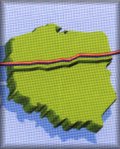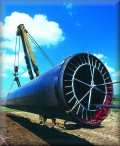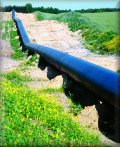


Kazimierz Adamczyk, Marek Gierlach
Europe is looking to its future. The fall of the Berlin Wall at the beginning of a new millennium is visible and obvious symbol of this. The idea of unity above all divisions is spreading in ever-widening circles, and is reaching far-flung --one might even say, exotic quarters. The race towards the future in the united Europe seems to have embraced us all. The basis of the much desired unity can be international co-operative projects in which all participants have equal gains.
The attractive vision of a common future should not obscure our awareness of a common historical legacy, especially as the two are intimately connected. Vision of vanished epochs inevitably accompany us from the moment of our birth and we often escape to the distant past to find inspiration in them and reflection concerning tomorrow. As a consequence of this past from destruction - what better can inspire and enliven our imagination than remnants snatched from the abbys of time?
Among these remains, a special place is occupied by the most ancient of them, archaeological finds. Hidden below the soil, covered in, fragile and often recovered only in fragments, dirt and often less than attractive in themselves, it is this material which becomes the source of our collective memory of a Europe without frontiers - a Europe of peoples. It is these monuments of the past which seem to be - despite the role they have come to play - which are most threatened by the processes so characteristic of modern civilisation - development.
It is no surprise to find the that most civilised nations have legal provisions developed as to afford the most effective protection of the heritage of our collective past. Here we recall the words of the International Charter on the Protection and Management of the Archaeological Heritage which states (Art. 3) that Development forms one of the most significant phisical threats to the archaeological heritage. The developer should therefore be under obligation of the investigation of the archaeological heritage before the beginning of the development...
We were aware of these words when we were planning the construction of the transit gas pipeline across Poland, a development which - it is the general opinion - has had a significant effect on the development of the archaeology in our country.
This construction is an exceptional operation. Never before has the gas pipeline of such parameters been constructed at such a rate. The project concerns a pipe of 1.4 m diameter which will run from the Jamal penisula in northwest Siberia to western Europe - a distance of over 4000 km. When it is operational, it will allow 64 000 000 000 m3 of gas to be pumped annually to Europe - gas which will be an ecological energy source and also an easily accessible from the energy. The Polish section of the pipeline which is about 682 km long is being built by the firm "EuRoPol GAZ" formed on the basis of an international agreement drawn up between Polish Republic and the Russian Federation.
In preparing for the construction of a linear development on such a scale, one could be sure that the pipeline would cut across many archaeological sites. The material evidence available to the archaeologists demonstrates the presence of human groups in this part of Europe for the last 500 000 years, beginning in the Ice Ages. The settlement of these lands increased in intensity which time, and left behind traces below the surface of soil, sometimes buried only very shallowly. These may be the traces of settlements with the remains of houses, different types of burial sites, industrial wites, workshops etc. Despite popular opinion, in such an operation, finding such remains is not difficult. Our company took these factors into account and undertook the planning of operations in such a way as to protect archaeological relics from irreversible destruction during the earthmoving operations.
The legal basis for the protection of the archaeological heritage in Poland is the Act "Concerning the Protection of Cultural Property" of 1962. It was written several decades ago in different social circumstances, and there is general agreement that it practically no longer fulfils its role. It does not define the precise extent to which the developer should carry out the necessary rescue work, nor does it define the precise mode of their financing. Close study of this document however raises many doubts which may lead to the possibility of an interpretation which can only cause destruction of the archaeological heritage.
We did not feel therefore that the ideal solution to the conservation dilemma that our operations created was to operate only within the bounds laid down by this law. As a result in EuRoPol GAZ we accepted the following principles.
a. The developer will finance all necessary measures to conserve the archaeological heritage,
b. All archaeological sites lying on the line of pipeline will be investigated by archaeologists,
c. The resulting material and data will be fully processed and published,
d. The archaeological finds will be permanently preserved and the most valuable of them will be publicly displayed.
We also had to decide who to enrust with the execution of the work on these sites in a manner least likely to disturb the progress of the construction of the pipeline. There are several schools and traditions in of Polish archaeology, but the fact that there was a general lack of experience in conducting large scale rescue did excavations was disturbing. In such a situation, the unification of methodology became a pressing need.
Within EuRoPol GAZ an archaeological section was created which co-ordinated the planned work. A standard contract was drawn up which would bring the work carried out in different regions into a homogeneous framework. Contact was established with the provincial archaeological offers in the conservation services who would have control over the archaeological aspects of the development process.
The first step of this work was the conducting in 1993-4 surface investigations (fieldwalking) of the entire route of the pipeline. As a result 724 sites of varying degrees of complexity were found. Of these 142 were the subject of rescue excavations preceding the beginning of the development, 166 were examined in the first stages of the work preceding the laying of the pipe, the other sites, all of them of small extent and predicted low cognitive potential, were subject of watching briefs during the earthmoving operations. The total area examined was about 45 hectares.
The execution of this work was enthrusted to archaeological institutions and other bodies able to demonstrate several years experience of considerable knowledge of local research problems. In order to carry out this work they often united into large consortia.
Once the stage of work involving fieldwork was finished, the analysis of the results was immediately begun, supplemented where necessary by specialist analyses; anthropological studies of the human remains, analyses of preserved pollen, radiocarbon dating etc. It is generallu accepted, that like all scientific work, the data coming from excavations should be processed in order that the investigative process can be considered finished. Unfortunately previous experience in this field has not always been a happy one. Often after the completion of the fieldwork - often the most costly stage, there are no financial resources left for the systematic synthesis of the results. In the light of these sad experiences we established the principle that the results of these excavations will be made available to all interested tn the form of a multivolume publication. The first volume of this publication appeared in the spring of 1988.
The most difficult problem of all remained to be resolved, the presentation and storing the archaeological finds recovered as a result of these efforts. Understanding the presence plight of existing museums in Poland we took the initiative and adapted a historic granary in such a manner that the converted interior houses huge storerooms, workplaces for scientists and also an exhibition room showing the most interesting archaeological finds. This structure is at Szamotuły near Poznań (and just by one of the pumphouses of the pipeline).
None of these activities would have been possible without the huge involvement of a considerable part of the Polish archaeological community, for whom the pipeline created the opportunity to considerably widen the scientific database, but also to gain new methodological and organisational experience.
The principles of the voluntary co-operation of developer and archaeologist in the creation of an archaeological conservation programme has met with great interest not only from scientists. Our archaeological experience has to a large degree been utilised in the planning of the construction of a Polish network of motorways (work on which began in 1997).
It is still difficult to assess the importance of the discoveries made during the fileldwork. This will be the task of the investigators themselves. Let us recall that in the course of the investigations, have found the remains of 314 settlements campsites and production sites - including several hundred houses (both at ground level and those with sunken floors). Other features include those with various functions, such as pits for smoking food, storage pits, lime kilns, and pottery kilns. We have explored 28 cemeteries with over three hundred graves (both cremations and inhumations) and several pagan sanctuaries. In chronological items they cover all of the more important archaeological cultures occuring in Poland, from hunter-gatherers of the Middle Palaeolithic, through the cultures of the first farmers, settlements of the Bronze and Early Iron Age contemporary with the famous settlement at Biskupin, through to the beginning of the Polish state.
Among the more spectacular discoveries belong:
- an industrial complex for extracting salt from salt springs in Przeworsk culture settlement of the Roman Iron Age in Chabsk near Mogilno, dated to the turn of the eras,
- a complex of sanctuaries of the Przeworsk Culture of the first centuries AD, together with associated animal burials at Sławsko Wielkie near Kruszwica,
- a rich cemetery of the Wielbark Culture of the Roman period and connected with the presence of Goths in Kowalewko near Oborniki Wielkopolskie.
- Neolithic settlements of longhouses in Żegotki near Strzelno, and Kuczkowo and Siniarzewo near Zakrzewo.
In conclusion please allow me to indulge in a personal reflection. Among all these spectacular discoveries, my attention was drawn by a hut which had been built by early farmers at Karczyn near Bydgoszcz. The aerial photographs revealed an elongated trapezoidal shape indicating a capacious and undoubtedly functional building. It would seem that the inhabitatnts of this structure, who had brought to the area new creative economic methods lived among the virgin forests surrounding them in perfect harmony with the natural world surrounding them, happy and free from the worries that would affect generations who would come after them. This picture was shattered by the pollen samples taken from the site, which uncompromisingly demonstrated an environment which was devastated and strongly polluted, in short, well on the way to ecological sisaster. Maybe it is no accident that a considerable part in the recent discoveries of the complex processes occuring in the past is played by a firm for whom far sighted activities concerning the protection of the modern natural environment through the promotion of a clean energy source prehistory is one of the most important of priorities.
BACK
